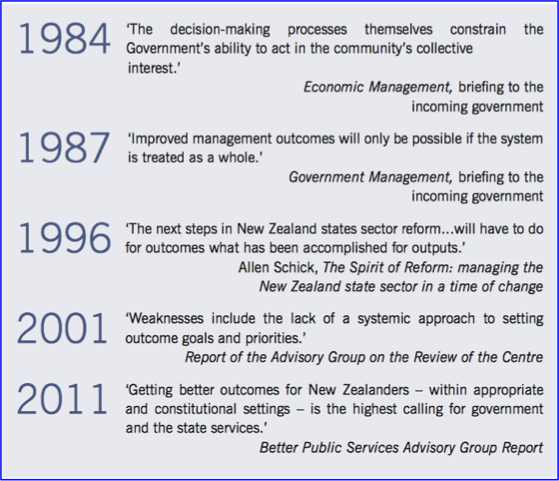I'm thinking about... |
Agreeing your why is the ultimate steering towards understanding your common agenda and creates the momentum needed for the right actions! Nazanin Jenkin Getting started - back to basics
(originally published on LinkedIn) Why collaborate Collaboration is not necessarily suitable or wise for all projects and outcomes. It is best suited to complex problems that demand effort to achieve a change. So in the first instance take as much time as you need to agree what you are collaborating on. Having identified an "opportunity or issue", take time to go deeper and look at the identified "needs" from the variety of perspectives. Then re-think the early problem/opportunity definition. Is there one (or more) common big opportunity or issue that requires collaboration or a variety of small isolated matters that can be handled independently, supported by communication and coordination? Investing in this first stage will save time later, avoid re-work and duplication. Recently I have heard a re-occurring rhetoric, "don't talk - act", with an apparent agenda to drive quick and early action. The risk is, this becomes busyness for the sake of busyness, which is wasted effort, breaks down good will and trust, and builds frustration. So don't let consultants or managers or politicians fool you into thinking this early effort is wasted time. Through my research I developed the iceberg model of collaboration, which showed that the problem definition usually gets buried deep down under other "noise". With the right approach and facilitation, once you have identified the needs and (usually revised) problem definition or opportunity - you can quickly develop an action plan. Recently, following some months of collective work with a variety of governance groups, the leadership team and managers across the organisation in the first stages, I facilitated a collective impact sprint session where integrated groups of kamahi, serving large customer segments across circa eighty service contracts, designed their collective action plans in four hours! In four hours we had agreed integrated plans for the next five years, because we had developed quality foundations first. Together we identified their "quick wins" and they will have their first collective projects completed before the close of 2018. Successful delivery of these early initiatives builds confidence for future investments and longer term projects - my recommendation would be to showcase early and often. Voilà, and there you have it, momentum and capability developed organically! Do we understand each other More often than not we just need to start with the basics, and giving careful attention to the language is so very important. Collaboration can mean different things to different people - even those sitting at one table. The Oxford dictionary’s definition is, “the action of working with someone to produce something”. A little limiting, I think. Selden et al. showed it is actually a continuum that spans “cooperation” through to “service integration”. They said, “On the one end is inter-organisational cooperation, supported by informal and personal relationships between management and staff of different organisations. On the other end is formalised service integration, in which two organisations work together to provide a new package of services to their mutual clients”. In “Managing for Joint Outcomes”, a research project undertaken by the Victoria University School of Government on behalf of the New Zealand public service, Ryan et al. said collaboration entails not just “co-existence” (working alone), “communication” (talking together), “cooperation” (getting together) or “co-ordination” (working together), but something more: namely, “collaboration” (sharing work). Building on this, in a recent LinkedIn article (which I shared), Bill Ryan said collaboration is "..where participants drop their 'I' and become 'We', merging all into a set of common culture, processes, practices and resources. Responsibility and accountability are collective. Mature, effective co-design demands full collaboration between participants ('partners') and, in theory at least (there is some evidence to back this up but a fair amount of faith among believers), is the most likely means to achieve sectoral or whole-of-government goals and objectives (desired outcomes) sought in policy." First steps - going beyond good intentions Never assume that there is a shared understanding of the problem definition or opportunity being sought, the purpose for collaboration, the desired outcomes for collaboration or indeed what "collaboration" means or looks like. Take the time needed to explore and agree and keep those agreements as the anchor for the journey. Be prepared to adapt and allow some flexibility - life is not static and things change. We are working in complex adaptive eco-systems - so if you are just focusing on one aspect, it's likely something else is changing and impacting the whole, under the radar. But keep key touch points and use them to steer the way forward. Moving forward we need to promote a culture that is comfortable with ambiguity and the unknowns; enable ongoing opportunities to learn from failures; and, embrace diversity of thought across portfolios. And, it's time to go beyond "good intentions". So going beyond good intentions, my suggestions are:
Copyright ©2020 Nazanin Jenkin Ltd. | www.nazaninjenkin.com | nazanin@nazaninjenkin.com | +64 21 478253
0 Comments
An edict to collaborate doth not collaboration make. Nazanin Jenkin Fill your kete (originally published on LinkedIn) An edict to collaborate doth not collaboration make...yet somehow, I see this sort of expectation again and again! The thing with collaboration is that folk think they get it and in some way many have some sort of an intuitive understanding of what it is. However, this in itself can be a problem and simply reduce collaboration to a buzzword! We've got to go beyond gut instincts and buzzwords and fill our kete (basket). Collaboration doesn't just happen - it needs to be a strategic decision, supported by a change implementation programme. It seems so bizarre to expect folk to wake up one day with some renewed thinking that tells them how and when to collaborate, because politician(s) or senior leader(s) decided it was the way to go. Some effort is required to deliver successful collaboration and we have to understand the context, to fully comprehend the effort that is needed to deliver what is essentially a new way of working across the NZ pubic sector. Here I share a small sample of my research literature review where I looked at this context. Trajectory of New Zealand Public Service Reforms In the quest for better public services from the mid-1980s through to the mid-1990s almost every aspect of “public management in New Zealand has been redesigned, reorganised, or reconfigured in some way” (Boston & Pallot, 1997, p.382). Through the 1990s this change was heavily influenced by Hood’s work on New Public Management (NPM) (Hood, 1991,1995). It had a strong focus on changes in public accounting and was embraced at the time by many as a paradigm shift for the public sector from public administration and management (PAM) (Christensen & Lægreid, 2002; McLaughlin, Osborne, & Ferlie, 2002; Osborne, 2006). The New Zealand reforms through the decade 1986 -1996 were considered by some to be “a more severe approach” (Pollitt & Summa, 1997) and by others as being radical and progressive (Duncan & Chapman, 2010, 2012). In 1996, Schick undertook a review of the New Zealand reforms, which drew some constructive conclusions and highlighted a range of areas for consideration (see Duncan & Chapman, 2010). In 2008, two decades following the reforms Graham Scott (2008, p. 4) stated that: “After 20 years of experimenting the government should try again to get to grips with the real issues….and chart a course that is more promising than the one we are on.” In broad brush summary, having "dabbled" in some way with New Public Management (NPM), New Public Value (NPV), and, New Public Governance (NPG), in 2011, the then National Government introduced Better Public Services (BPS). See trajectory summary below - from “Picking up the pace in the public services” by A. Morrison, 2014. The early reforms delivered some efficiency gains, largely through reduced headcount, but were unable to deliver increased effectiveness and the desired outcomes. As Andrew Kibblewhite, Head of Policy Profession (HoPP) indicated in a 2015 address to the Institute of Public Administration New Zealand (IPANZ) “the momentum they tantalisingly promised to deliver didn’t eventuate”. Competition to Collaboration Whilst I don't want to over simplify the complexities of reforms and policy making and I acknowledge that there are many scholars more learned than I in this field - it is evident that the move to BPS was essentially a move from a competitive model of service delivery to a collaborative model. We are now once again in a new era, with the introduction of the first New Zealand "Wellbeing Budget" by the current Labour-led Government and the "re-introduction" of the four-wellbeings for Local Government. Successful delivery of this approach is absolutely reliant on successful collaboration across some complex portfolios and issues. However, to date, despite many policy initiatives that require collaboration, on the whole the anticipated changes to a transformational collaborative public services delivery have yet to eventuate. We have definitely seen pockets of success (examples include: SmartStart, the Healthy Homes Initiative and the Kaikoura Harbour Remediation to name some); but we have yet to experience the anticipated transformational new way of working and integrated delivery approach across services for citizens, communities and whānau. Having journeyed a pathway of "competition" for so many years, it seems it should be obvious that some effort is needed to turn the tide around to "collaboration". This is fundamentally a new way of working, requiring different skills, competencies and capabilities and undergirded by a "new" approach to leadership. We have a workforce trained in the old way of working and a system designed for essentially silo delivery across agencies and local authorities. As mentioned already, though we have seen some successes, often against all odds, overall we continue to work in a culture that has a dominant fear of failure, continues to struggle with diversity and rewards "known knowns". Even when we enable collaboration, we do not incentivise it and so the effort appears to be wasted. And, if delivering collaboration across teams and organisations in this environment wasn't challenging enough, “generation collaboration” brings four generations of employees together and has to be relevant to all. In short, bringing successful collaboration to fruition is no mean task for any leader. As one US politician is famously quoted as saying, "Collaboration is like cottage cheese. It occasionally smells bad and separates easily." Fundamentally, collaboration is a strategic change programme that requires set-up, the right people, capability development, resource allocation, an implementation plan etc. Delivering complex portfolios of change across multiple organisations doesn't just happen because it's a good idea! Filling our kete Increasingly, my work with organisations takes us along the whole journey: why, what and how - strategy to implementation, supported by capability development. The lines between strategy and OD are blurred as we move into the collaboration arena. Maybe as a nation of rugby lovers we can draw on some learning from the sport – a coach would not pick any individual club player and expect them to perform at test match level without appropriate training and practice: nor can leaders expect that of employees. It takes time, effort and investment to be ready on game day. Further, rugby players work and compete separately when members of a club team but, when they come together as the All Blacks – they are one. There has to be provision of environments for learning, in a controlled way, where we can fail safely and learn from that learning quickly. It’s exciting to see examples of these rising in NZ such as the Service Innovation Lab in Wellington and the Auckland Co-Design Lab, to name a couple. There are also workshops and seminars where folk share their learning working with collaboration, a number of which I have been privileged to be part of. The conversations are dynamic and the desire to learn palpable. However, even though there are enthusiasts for this new way of working, for the majority learning how and when to use these sorts of environments and the approaches they offer can be challenging enough. The transition from traditional old ways of working to dynamic and adaptable approaches has been slower than anticipated. We need to find ways to increase the momentum and grow the champions. For those of us that want to work in this new way and lead in this arena, we have to own our own learning and fill our personal kete with tools and frameworks. It takes time and it’s an investment, but heck it’s worth it! After a number of years of research, practice and wānanga- one thing I am certain of: there is absolutely no “one” way or approach that is suitable for all situations. Each framework that I have looked at, trained in, and “played with” has some value to add – but the clever bit is learning how to mix and match and integrate for the specifics of the context and people and culture. Moving into the maturity of working in this new collaborative way will take time and we will make mistakes along the way, but that should not stop us taking steps in the right direction. The internet offers us unprecedented opportunities to learn with global communities and learning can be an exciting adventure. In an earlier article I talked about some key collaborative behaviours and skills. Building on that, some collaboration frameworks and approaches that I have found useful include: Appreciative Inquiry, the Cynefin Framework, the Constellation Model, Collective Impact, ISO 44001, Twyford's Power of Co. and Design Thinking. I don't believe in "standards" per se - they're all tools and frameworks that can add value at any given point. Therefore, I choose not to be “an apostle” for any one approach, but rather to work with a portfolio – I am still on a journey and my learning has been to not hold on to any specific approach too tightly, to be open and to listen closely. In my work I design workshops and training to suit the needs of the context. In my next article I will take you through the first steps of getting started with a collaboration initiative. Copyright ©2020 Nazanin Jenkin Ltd. | www.nazaninjenkin.com | nazanin@nazaninjenkin.com | +64 21 478253 References
|
Nazanin jenkinNazanin Jenkin Archives
September 2021
Categories
All
|



